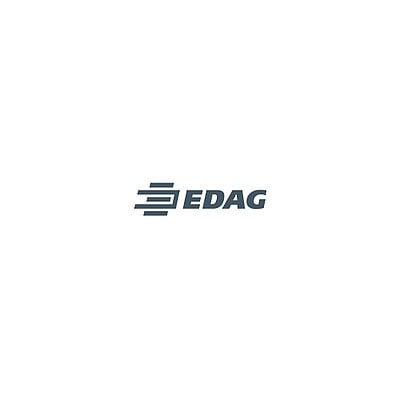Whenever the question of the digitalization of an industry arises, employees quickly start to worry about complicated work processes, weeks of computer training and extra work due to constant breakdowns. In actual fact, the opposite is the case: increased efficiency, greater citizen satisfaction and relief from mindless tasks are among the goals of the digitalization initiatives in the healthcare sector. With its step-by-step digitalization concept, EDAG shows how such a modernization project can effectively succeed.
The German healthcare system has not yet reached the technical and organizational standards possible with the tools and solutions available. As a result, employees still have to input the same data twice, laboriously export and send data records instead of transferring them from one application to another at the touch of a button, and create information sheets and certificates manually. Other tasks are left unattended or can only be handled after the scheduled time, often causing additional work elsewhere.
The vision of a digitalized public health service could be the answer: Integrated solutions instead of media disruptions and stand-alone solutions, (partially) automated processes, or even self-service portals for citizens, where up-to-date information can be accessed, and certificates automatically created and transmitted following legitimization.
Ways to achieve a digital public health service
There is still a great deal to do before this vision can become reality everywhere. At any rate, the government has come to the conclusion that simply providing millions for funding is not enough. The "maturity model", on which current funding applications are based, was developed under the Public Health Service Pact. This takes into account the fact that the initial situation and levels of knowledge vary greatly from one district or city to another, as does the support provided by the various federal states.
The main purpose of the maturity model is to assess the current situation. To this end, 200 criteria are divided into eight fields ("dimensions") and the maturity levels for each dimension are broken down into five levels. Using this as a basis, it is possible for digitalization projects to be precision-developed, and for individual measures for improving digital maturity to be prioritized as short-term, medium-term or long-term subprojects. Further support with the definition and working out of digitalization goals and concepts is provided by the recommended activities, which represent initial experience in the form of best practices within the dimensions and sub-dimensions.
Further support with the definition and working out of digitalization goals and concepts is provided by the recommended activities, which represent initial experience in the form of best practices within the dimensions and sub-dimensions.
External support needed
However, not even this tool is able to overcome the greatest obstacle: the severe staff shortages in public offices, local authorities and healthcare facilities. Manpower aside, in some areas there is also a lack of know-how, i.e. of IT expertise and project management experience, but also of concepts for digitalization which are explicitly geared towards increasing efficiency potential.
This means that health departments need external support: At the very latest with the implementation of the project, but often enough during the project development phase, and also with applications for the necessary funding. One possible partner that meets the requirements for this task is the EDAG Group. Its Public Services department has acquired many years of expertise in the healthcare sector, along with experience in the entire public sector and the integration of public services in all areas of administration.
EDAG has already demonstrated its competencies in several projects in the healthcare sector. Examples of this are the "Smart Care in Rural Areas" project carried out by the district of Giessen and the establishment of the ELFA Interoperability Office in the public health service of the state of Hesse.
The services include the development of digitalization concepts and projects based on the project ideas of the people in charge and the requirements identified. EDAG takes on classic project office activities, searches for any additional partners required, provides support with applications for funding, and carries out the necessary maturity level measurements. The digitalization experts can draw on their experience with various funding formats, e.g. the Public Health Service Pact, smart city model projects, etc.
One particularly important aspect of digitalization is to implement new, more efficient processes which will take advantage of the new capabilities of a more digitalized infrastructure. In process modeling, for example, (partial) automation might be considered as a way of relieving employees of repetitive manual tasks, so freeing up time for more complex tasks and also reducing overtime.
In addition, EDAG's services also include the coordination of several contractors with similar interests. Joining forces to form alliances enables the partners to work together to find and develop solutions, cutting both the workload and the cost. The parties involved also benefit directly from the other partners' experience and ideas for improvement.
Spotlight on employees
EDAG puts a strong focus on the involvement of employees – not simply as participants in training courses, but as people involved in the project and carriers of valuable knowledge, who help to enhance and shape the project. A sensitive approach is often needed here to help the people concerned open up and share their worries and fears. Where necessary, this can also take the form of one-to-one discussions.
This is important because not only the employees' knowledge levels and attitudes, but also their expectations and requirements need to be identified at an early stage. Apart from the implications this has on IT equipment and the choice of specialist applications, it also determines, among other things, how much training is required, what content to focus on, and how future communication needs to be organized in the course of the project. This is a key success factor when it comes to the success of a project of this type.
To give an example: It often happens that users who are not fully aware of the implications of impending changes tend to cling to processes which, though familiar, are inefficient - and which take even more time and effort to implement with the new systems. The important thing here is to clearly outline the changes, then show what the new processes look like and how efficiency gains can be achieved. A failure to adequately communicate the added value of digitalization will soon lead to a lack of support for the project and the rejection of innovations. As a result, daily work processes are fraught with inefficiencies and, in the worst case, there is a risk of increased staff losses.
For this reason, off-the-peg solutions are not generally suited to the digitalization of the public health service. EDAG's response to this is to develop individual concepts which take the initial situation and levels of knowledge of the people involved into account, along with other factors such as the specialist applications used or the support provided by the federal state concerned. This means that in some administrative offices, the responsibility is in the hands of central service departments or specific digitalization officers who play a leading role in such projects, while in other towns and cities the mayor is responsible for decision-making, or there is a separate department for all kinds of projects.
In addition, some of the services offered by the public health service correspond to smart city services, so attention must also be paid here to the extent to which networks or consistent user interfaces of citizen portals need to be taken into account. This, too, is part of a future-proof IT landscape that can easily be future-proofed to meet smart health developments and requirements.
Are you planning a digitalization project in the public health service? Then talk to our public health service experts: Specialist consultants for smart health, Dr. Nicole Richardt (project leader), and Nicole Moser; or to Judith Schultze, Business Development & Sales at EDAG. Or download our white paper "Paving the Way for the Digitalization of the Public Health Service" here. Further details on the public health service maturity model, on which steps have proved successful in the digitalization of the healthcare sector, and tips tips on how to find a suitable external partner can be found here. 





